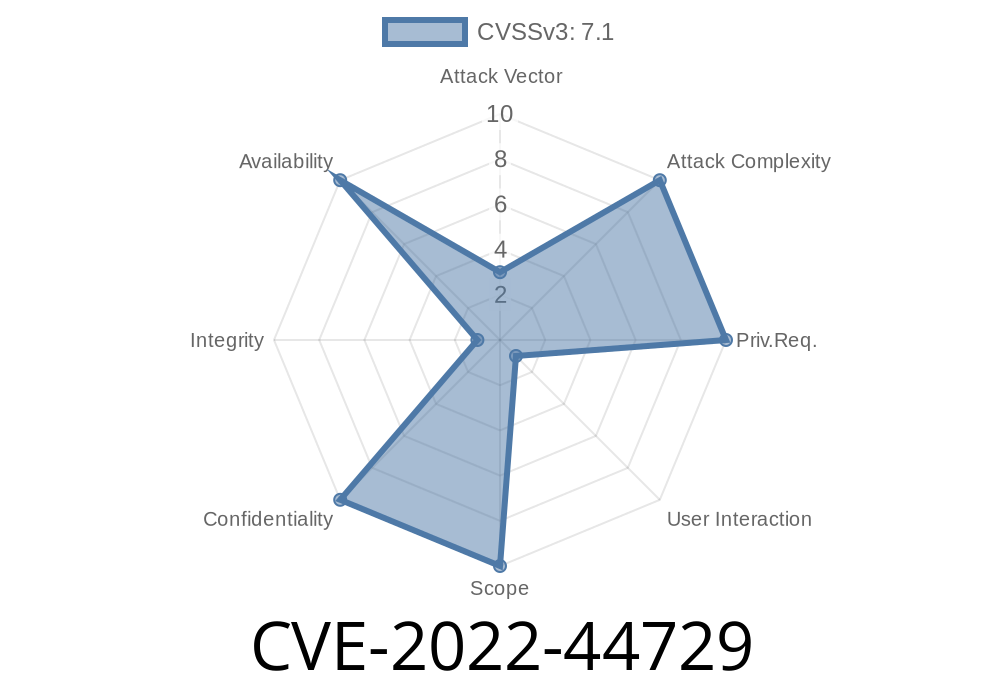The Apache Software Foundation recently announced a significant vulnerability in Apache XML Graphics Batik, affecting version 1.16. This vulnerability is classified as CVE-2022-44729 and results from a Server-Side Request Forgery (SSRF) issue. It allows an attacker to trigger loading external resources, which could lead to resource consumption and, in some cases, information disclosure.
In this long-read post, we'll dissect the vulnerability in detail and provide recommendations for users to protect themselves. We will also highlight the code snippet responsible for the SSRF issue and explore its exploitation.
What is Server-Side Request Forgery (SSRF)?
Server-Side Request Forgery (SSRF) is a security vulnerability that allows an attacker to make arbitrary HTTP requests on the targeted server's behalf. This can lead to unauthorized access to internal resources, bypassing access control mechanisms, and even potentially extracting sensitive data.
Apache XML Graphics Batik 1.16 SSRF Vulnerability Details
The SSRF vulnerability in Apache XML Graphics Batik affects version 1.16, wherein a maliciously crafted SVG file could trigger loading external resources by default. This may lead to resource consumption, tying up server resources, and making the server unresponsive. In more severe cases, it could even result in information disclosure.
For instance, consider the following malicious SVG file
<svg xmlns="http://www.w3.org/200/svg">;
<image href="http://100.100.100.100"><metadata><!-- Some data here --></metadata></image>
</svg>
By embedding this file within a web application using Apache XML Graphics Batik, an attacker can cause the server to load the external resource by default, leading to the SSRF vulnerability.
Mitigation
To protect against this vulnerability, users are urged to upgrade their Apache XML Graphics Batik installation to version 1.17 or later. The release notes for the updated version can be found here:
- Apache XML Graphics Batik 1.17 Release Notes
In addition to the upgrade, users can also apply certain configuration changes to reduce the risk associated with this vulnerability. One such mitigation strategy involves disabling the loading of external resources by setting the appropriate security settings within Batik.
For example, in the code snippet responsible for setting up the Batik configuration, users can disable external resource loading like so:
// Import the relevant Batik packages
import org.apache.batik.bridge.UserAgent;
import org.apache.batik.bridge.UserAgentAdapter;
import org.apache.batik.bridge.DocumentLoader;
// Customize the UserAgent to only allow loading local resources
UserAgent userAgent = new UserAgentAdapter() {
@Override
public boolean allowExternalResource(String uri) {
return false; // Disallow external resource loading
}
};
// Create a new DocumentLoader with the custom UserAgent
DocumentLoader documentLoader = new DocumentLoader(userAgent);
This configuration change effectively mitigates the SSRF vulnerability, as external resources are no longer loaded by default.
Conclusion
CVE-2022-44729 highlights the importance of promptly addressing security vulnerabilities in open-source software. By understanding the SSRF vulnerability in Apache XML Graphics Batik and applying the necessary changes, web application developers can protect themselves and their users.
We highly recommend all Batik users update to version 1.17 or later and apply the appropriate configuration changes to prevent external resource loading. This greatly reduces the risk associated with this vulnerability and helps maintain a secure and stable web application environment.
For further information about this vulnerability and its implications, consult the Apache XML Graphics Batik Security Advisory. Stay informed and keep your software up to date to protect yourself against future vulnerabilities.
Timeline
Published on: 08/22/2023 19:16:00 UTC
Last modified on: 10/30/2023 02:17:00 UTC
